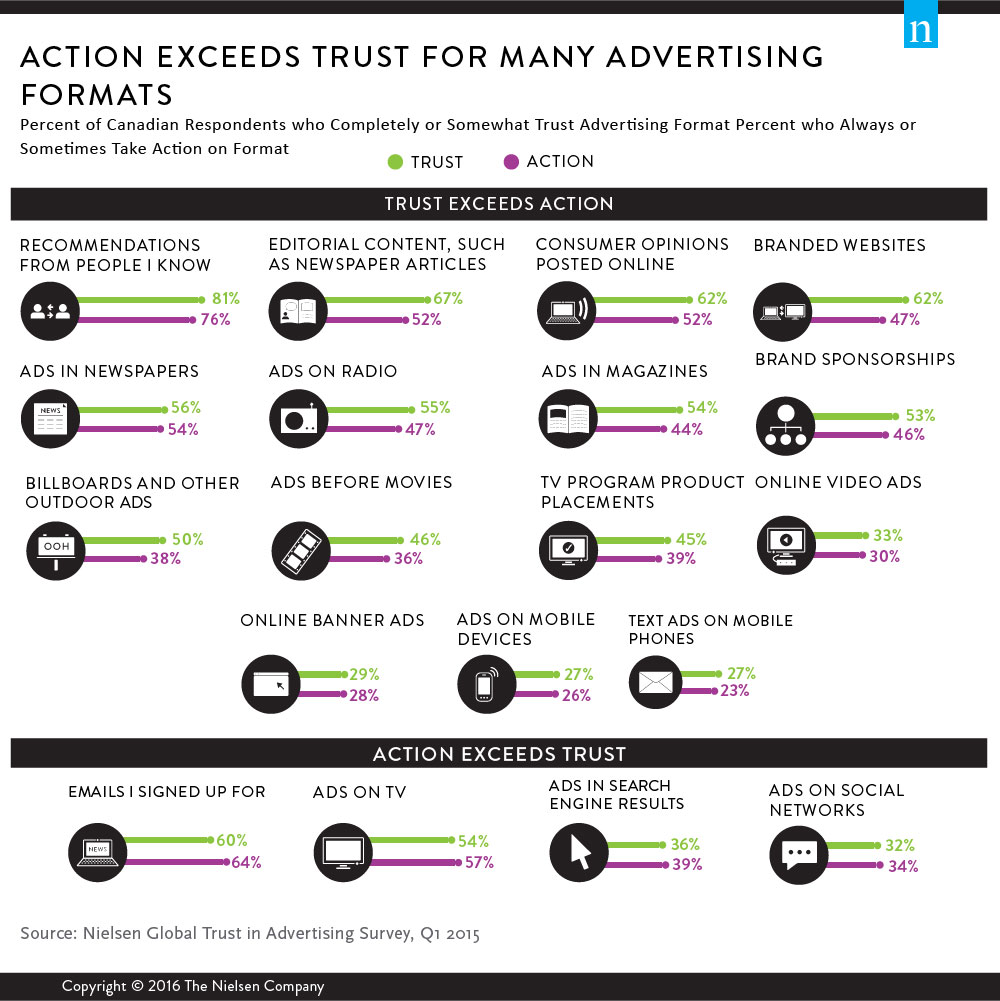It’s somewhat natural for consumers to be skeptical about advertising, but when it comes to paid advertising across traditional and digital media, Canadians have a higher level of distrust than their U.S. counterparts. In fact, Canadian online respondents in Nielsen’s most recent Global Trust in Advertising survey rank among the least trusting of paid ads globally.
As discussed during a recent Association of Canadian/Nielsen Media Canada Advertisers event in Toronto, Canadians trust independent or impartial forms of advertising the most, and they regard personal recommendations as being the most reliable source of information. In fact, 81% of those surveyed say they completely or somewhat trust what people they know tell them. Along with newspaper editorial content or consumer opinions posted online, respondents around the globe, not just in Canada, view these unpaid earned forms of advertising with little cynicism.
On average, 70% of Canadian respondents say they trust these forms of earned media, compared with 51% for paid advertising on traditional media and only 31% for digital advertising. Despite the continued proliferation of media touchpoints and the ubiquity of paid advertising, many newer forms of digital advertising don’t inspire trust among viewers in the same way that traditional, more familiar media does. While the overall trust of TV, radio and magazine advertising in Canada is lower than elsewhere globally, these mediums are still trusted by a majority of Canadian respondents.
Similarly, and no doubt influenced by this lack of trust, Canadians are also less likely to take action based on the ads they see. While this is the case across all forms of advertising, including earned and owned media, levels are particularly low for paid forms of advertising. In fact, fewer than one-in-three Canadian respondents say they will take action as a result of seeing a digital ad. TV is one of the few mediums where Canadian respondents claim a higher degree of action (57%) than trust (54%).
Three-in-five Canadian respondents trust emails from advertisers that they have explicitly signed up to receive (60%). But opting in to an advertiser’s email bulletin doesn’t guarantee that recipients will trust the messaging. In fact, a significant portion (40%), conversely, have lower levels of trust in the content they invite into their inbox. Even so, however, Canadians are more likely to take action because of an advertiser’s email than all other forms of advertising except word of mouth.

Trust and action among Canadians are particularly low for online ads, mobile ads and even ads on social networks. But with consumers becoming increasingly reliant on mobile devices, advertisers need to be connected to their prospects in real time, with the ability to get their messaging directly into the hands of consumers—and have it resonate in a meaningful way.
Trust in digital advertising, however, is on the rise. In looking at data from 2007, when digital advertising was arguably less sophisticated, we see that overall sentiment toward digital advertising has improved, particularly with respect to text ads on mobile phones, where trust levels grew from 18% to 27%. In that vein, the industry should believe with better targeting, better relevance and greater personalization, trust will continue to improve among a still wary Canadian audience.
ABOUT THE NIELSEN GLOBAL SURVEY
The Nielsen Global Trust in Advertising Survey was conducted between Feb. 23, 2015, and March 13, 2015, and polled more than 30,000 consumers in 60 countries throughout Asia-Pacific, Europe, Latin America, the Middle East, Africa and North America. The sample includes Internet users who agreed to participate in this survey and has quotas based on age and sex for each country. It is weighted to be representative of Internet consumers by country. Because the sample is based on those who agreed to participate, no estimates of theoretical sampling error can be calculated. However, a probability sample of equivalent size would have a margin of error of ±0.6% at the global level. This Nielsen survey is based only on the behavior of respondents with online access. Internet penetration rates vary by country. Nielsen uses a minimum reporting standard of 60% Internet penetration or an online population of 10 million for survey inclusion. The Nielsen Global Survey, which includes the Global Consumer Confidence Index, was established in 2005.



